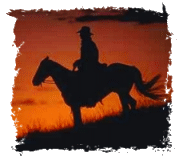

Fall
River County, South Dakota
- In 1743 the sons of French
explorer Pierre Gaultier de Varennes, sieur de La Verendrye, left
a dated plaque on a bluff overlooking the Missouri River near what
is now known as Pierre, marking the first white exploration of
South Dakota. The journals of Jean-Paptiste Truteau, of the
Missouri Co. and the maps of James McKay and John Evans, were used
by Meriwether Lewis and William Clark on their expedition up the
Missouri River.
-
 One
of the first to arrive after Lewis and Clark was Manuel Lisa a
trader from St. Louis. He built Fort Manuel near an Arikara
village on the Missouri. The interpreter at this trading post was
Toussaint Charbonneau, who was the husband of Sacajawea, Others
followed including, Jedediah Smith, Jim Bridger and
others.
One
of the first to arrive after Lewis and Clark was Manuel Lisa a
trader from St. Louis. He built Fort Manuel near an Arikara
village on the Missouri. The interpreter at this trading post was
Toussaint Charbonneau, who was the husband of Sacajawea, Others
followed including, Jedediah Smith, Jim Bridger and
others.-
- The first steamboat to come
this far north was the Yellowstone,
from then until the arrival of the railroad in the 1870's
steamboats plied the waters of the Missouri. They brought much
needed goods from St. Louis to Fort Pierre. Forts and trading
posts dotted the banks of the Missouri and many became the
foundations for today's cities, such as Yankton, Vermillion,
Chamberlain and of course Pierre.
-
- The Treaty
of Fort Laramie in
1868 established the Missouri River as the boundary of white
settlement. And west of the river became the Great Sioux
Reservation. For the Sioux and the Cheyenne, who had come to the
area a few generations prior to the arrival of the white man, the
Black Hills were hallowed ground.
-
 The
band of the Teton Sioux were led by chiefs and warriors who became
the legends of the American West: Red
Cloud and
Crazy
Horse of the
Oglala, Spotted Tail of the Brule, Big
Foot of the
Miniconjou, and
Sitting
Bull of the
Hunkpapa. The most famous Battle was The
Battle of Little Big
Horn. Although the
Indian Nations won this was the beginning of the end, their final
defeat was inevitable.
The
band of the Teton Sioux were led by chiefs and warriors who became
the legends of the American West: Red
Cloud and
Crazy
Horse of the
Oglala, Spotted Tail of the Brule, Big
Foot of the
Miniconjou, and
Sitting
Bull of the
Hunkpapa. The most famous Battle was The
Battle of Little Big
Horn. Although the
Indian Nations won this was the beginning of the end, their final
defeat was inevitable.-
- South Dakota continued to gain
in white population from 10,000 in 1870 to 348,000 by 1890. Many
of the new inhabitants were from Northern Europe already
accustomed to the climate that South Dakota afforded. They were
from Norway, Sweden, Russia and Finland.
-

- Gold and rumors of gold in the
Black Hills lured many to South Dakota. Many turned to farming the
fertile ground, or raising livestock after the rush was
over.
-
- Hot Springs (see
map) became a turn-of-the-century spa, these were the fad of the times. The Indians frequently camped at "Minne-kahta". The names of the warm water springs are, Catholican Springs, Lakota Springs, and last but definitely not least, Mammoth Spring. This spring is the largest in the Black Hills, with 10,000 gallons of water flowing per hour. Then in 1974 the Mammoth
Site
was found
(see
map). This site can be
visited and you can see an archeological "dig" in progress. Hot
Springs, is enclosed on the south by the Sawtooth Mountains,
Battle Mountain on the east and the Black Hills on the west and
north. Cold and hot brooks flow into the Fall River (from which
the county gets its name), which flows thru town and joins the
Cheyenne River south of Hot Springs.
-
- Fred Evans was a benefactor of Hot Springs. In 1875 he owned the Evans Transportation Company which was the largest in the west, hauling between Fort Pierre and the Black Hills. He built the Minnekahta Hotel (later the Evans Hotel) and Evans Plunge. He donated land for every church in town and the Soldiers' Home. He also paid for the water system, baseball team, and a city band.
-
- Fall River County's brief but rich western history is being preserved by the Fall River County Historical Society and their artifact collections are on display at the Pioneer Museum in Hot Springs. The museum is open daily to the public, Monday through Saturday from May 15th until October 15th. Please come visit, and tell them "Old Stu" sent you.
-
-
-
-
-

-
-
- If you have information, or links you would like to share please send it along to me and I will be happy to consider it for use on this site. Just click on one of the email icons below and drop me a note.


stufr@wrightprinting.com
RETURN to
Fall River Main
Page
or enjoy visiting one of these other
Fall River pages
Directory History Inquiries Links LookUps Send
Query
FUN News History Fall
River MAP

May, 1998





 The
band of the Teton Sioux were led by chiefs and warriors who became
the legends of the American West: Red
Cloud and
Crazy
Horse of the
Oglala, Spotted Tail of the Brule, Big
Foot of the
Miniconjou, and
Sitting
Bull of the
Hunkpapa. The most famous Battle was The
Battle of Little Big
Horn. Although the
Indian Nations won this was the beginning of the end, their final
defeat was inevitable.
The
band of the Teton Sioux were led by chiefs and warriors who became
the legends of the American West: Red
Cloud and
Crazy
Horse of the
Oglala, Spotted Tail of the Brule, Big
Foot of the
Miniconjou, and
Sitting
Bull of the
Hunkpapa. The most famous Battle was The
Battle of Little Big
Horn. Although the
Indian Nations won this was the beginning of the end, their final
defeat was inevitable.


